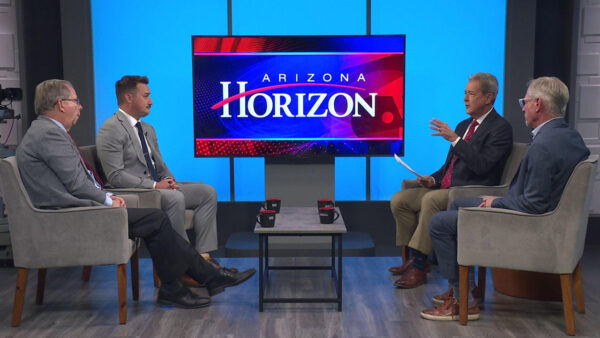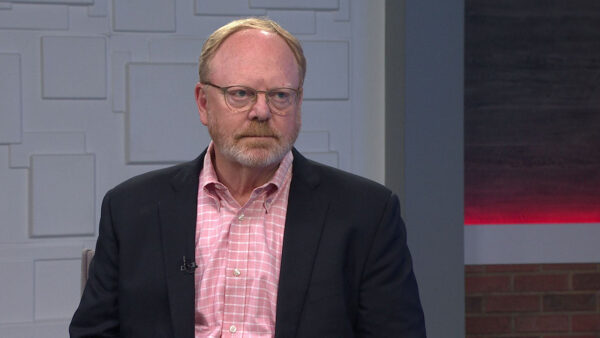There are more Hispanic students in Arizona public schools than non-Hispanic Caucasian students. Hispanics score over 20 points lower on the AIMS test than non-Hispanic White students. Dr. Kent Scribner, superintendent of the Phoenix Union High School District and a member of the White House Initiative on Educational Excellence for Hispanics, and Dr. Delia Saenz, an Arizona State University Associate Professor of Psychology and Vice Provost for Undergraduate Education at Arizona State University, will discuss the problems with Hispanic education in Arizona.
Ted Simons: To talk about challenges and solutions facing Hispanic education in Arizona is Dr. Ken Scribner, Superintendent of the Phoenix union high school district and member of the White House initiative on educational excellence for Hispanics, and Dr. Delia Saenz, an associate professor of psychology and vice provost for undergraduate education at ASU. We have 17,000 more Latino students in Arizona schools than white students. We have 20 points though lower on the AIMS test. What is going on out there?
Kent Scribner: One of the biggest issues is the historic approach to focusing on low income and language and minority students. Latino students are the largest, youngest, fastest growing minority population. Urban, low income schools are focusing on what I could call a deficit model and not focusing on maximizing success and investing in our students as the assets that they truly are.
Ted Simons: Is that deficit model a bad thing considering all other factors involved?
Delia Saenz: I don't think the deficit model is absolutely wrong, but it fails to take into account the complexities involved in creating success. As Dr. Scribner said, we need to build on strengths of students and create educational systems where their strengths are highlighted, where teachers have cultural competence, where parents are invited to get involved in the school and where all students are given an opportunity.
Ted Simons: Give us an example of building on strengths.
Delia Saenz: Sure, we have in our school systems, magnet schools for example that focus on science or biology. Where students are presented with opportunities rather than treated as if there is a deficit. And when given that type of encouragement, we have seen example after example where they succeed, go on to the next level and really are competitive in the educational system.
Ted Simons: Is that a different model than what has historically been used in public schools, and if it is a different model, why does it need to be different?
Kent Scribner: It absolutely needs to be different. We don't want to be like other large city systems, L.A., Chicago, Philadelphia, Miami -- dealing with Latino student in particular as problems that need to be fixed. We need to look at the students as assets to be invested in. Metrics, suspension rate, absenteeism, dropout rate, important things that we must attend to, if we only do that, you do that at the expense of middle achieving and upper achieving students, living in the urban core, low income Latino or language minority.
Ted Simons: The concept of cultural differences -- the fact that a lot of parents of the students, they don't have advanced degrees. Some didn't finish schools. They can't help them much with homework, how does that factor in?
Delia Saenz: This is true, many are not highly educated - but if you look at study after study it suggests that the number one priority for Latino parents is the education of their children. They're interested in having their kids succeed. They want to provide that opportunity. And they're willing to help the school system as well. The other thing we really can't think about our children as minority anymore, because if you look at the demographics of our state, Hispanics are the largest group already, and combine all minority groups together, they actually create the majority of students in our school population. It's not so much bending the norms to make it culturally responsive, it is creating the situation that serves the students that are in our pipeline now.
Ted Simons: More of a pipeline of diversity out there, how do you embrace diversity in the school system?
Kent Scribner: I don't think it is a function of -- a need for multi-cultural focus. I think it is a focus on rigor, access to honors courses, advanced placement. Our kids are smart. If we invest in them, if we push them, provide rigor, relevance in instruction, meaningful relations between adults and students, we will find it is the right thing to do. This is not some social justice rallying cry to help Latinos. This is arithmetic. They're 60% of incoming kindergartners, what Arizona do we want to live in in the next 10, 20, 30 years, Arizona success is Latino education success.
Ted Simons: Interesting that you mention raising expectations. That challenge it would seem to me would make a lot of sense. You say go do this. Let's see if you can do this -- most kids say I'm going to give it a shot or a try. Is it viable, though, again in such a massive public school setting.
Kent Scribner: Absolutely. We have small specialized programs, bioscience high school, one of our top performing gold medal from the Department of Education, police and fire high school, talking about a coding academy, small specialized, highly rigorous programs. This is the future work force. If we do not invest in this future work force, it is not only good for our students, it is good for business and Arizona.
Ted Simons: The magic word invest. Talk to us about that.
Delia Saenz: Exactly. Not just investment in students and programs but also in teacher development. Having them become certified, in terms of bilingual or in terms of special bioscience technology. Having them, giving them the tools that they need in order to be available for students, that's essential. You know, in 2012, Morris institute published a report that suggested that Arizona was at risk of becoming the second tier state educationally and economically. I think we risk that if we don't pay attention to some of the disparities that we have seen in our education system based on ethnicity and race.
Ted Simons: We have some good ideas out there. Things are happening. The robotics team made international headlines. Things are happening but yet still the achievement gap. Are we expecting the gap to close too quickly? Why aren't we getting better quicker?
Delia Saenz: That is the $64,000 question. I think there has to be a mindset change. We have seen programs across the country where teachers are trained to think about a growth mindset rather than a static mindset. It turns out when you train teachers to think about intelligence as something that is incremental or that can grow, it benefits everybody, not just minority kids. So, I think systemic change is needed here.
Ted Simons: Is systemic change going to take awhile? Do we have to be patient?
Kent Scribner: We don't have time to wait. We must invest today. We have magnificent, incredible, intelligent students. A student, Josh -- rode the bus to Burton bar library, builds web sites and blogs, made more money than the average Arizonan while in high school, graduated ASU, honors, 2 1/2 years, fastest ever and now runs a multimillion dollar digital marketing company. A kid, 22 years old, has employees all over the world. A Phoenix -- high school kid. They are in our schools. We must invest in them if we want to have a viable economy moving forward.
Ted Simons: How do we invest in them? What needs to be invested?
Kent Scribner: Exposure to rigorous curriculum. Our kids come to school, 83% of them living in poverty. Opportunity to earn college credit in the junior, senior year is crucial. Offer more AP classes. We have -- we have to continue to -- reach down to our elementary's and focus on rigor from pre-K to the university.
Delia Saenz: Likewise providing support so that student can afford to take the SAT and ACT and this allows them to be competitive for college. Low-cost investment but it can reap tremendous benefits.
Ted Simons: The best way to address this education gap you think is --
Delia Saenz: I think it is redoing the whole system, being responsive to the students, rather than continuing the same old pattern. Providing greater opportunity, raising expectations, and providing the students with the strength that they need to continue.
Ted Simons: Is it happening in certain areas but not enough areas? Is the tide slowly washing over the state?
Delia Saenz: I think it is happening in certain areas. Phoenix union is a perfect example of some programs they have there but we would like to see more of that and greater coordination between the high school level and earlier levels.
Ted Simons: That coordination is big.
Kent Scribner: Absolutely. Transform the culture. Move away from minimizing young people's failure and move towards maximizing their success.
Ted Simons: You're optimistic?
Kent Scribner: I am optimistic. We have no other choice. Our students are the adults of the future. Latino students our work force moving forward.
Ted Simons: Are you optimistic?
Delia Saenz: Very optimistic. I think once the whole state thinks of Arizona as the reality it truly is, they will invest, irrespective of rather the child is Latino, Native American, black, Asian, or white. That is where we need to head.
Ted Simons: Great to have you both here. Thank you for joining us.
Delia Saenz: Thanks.
Dr. Kent Scribner:Superintendent and Member, Phoenix Union High School District and White House Initiative on Educational Excellence for Hispanics; Dr. Delia Saenz:Associate Professor of Psychology and Vice Provost for Undergraduate Education, Arizona State University;























